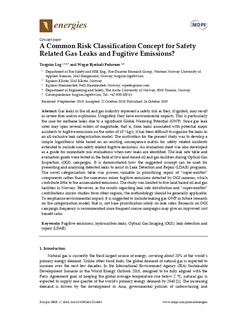| dc.contributor.author | Log, Torgrim | |
| dc.contributor.author | Pedersen, Wegar Bjerkeli | |
| dc.date.accessioned | 2019-10-30T13:25:24Z | |
| dc.date.available | 2019-10-30T13:25:24Z | |
| dc.date.created | 2019-10-24T17:53:37Z | |
| dc.date.issued | 2019 | |
| dc.identifier.citation | Log & Pedersen. (2019). A common risk classification concept for safety related gas leaks and fugitive emissions? Energies, 12(21) | nb_NO |
| dc.identifier.issn | 1996-1073 | |
| dc.identifier.uri | http://hdl.handle.net/11250/2625432 | |
| dc.description.abstract | Gas leaks in the oil and gas industry represent a safety risk as they, if ignited, may result in severe fires and/or explosions. Unignited, they have environmental impacts. This is particularly the case for methane leaks due to a significant Global Warming Potential (GWP). Since gas leak rates may span several orders of magnitude, that is, from leaks associated with potential major accidents to fugitive emissions on the order of 10−6 kg/s, it has been difficult to organize the leaks in an all-inclusive leak categorization model. The motivation for the present study was to develop a simple logarithmic table based on an existing consequence matrix for safety related incidents extended to include non-safety related fugitive emissions. An evaluation sheet was also developed as a guide for immediate risk evaluations when new leaks are identified. The leak rate table and evaluation guide were tested in the field at five land-based oil and gas facilities during Optical Gas Inspection (OGI) campaigns. It is demonstrated how the suggested concept can be used for presenting and analysing detected leaks to assist in Leak Detection and Repair (LDAR) programs. The novel categorization table was proven valuable in prioritizing repair of “super-emitter” components rather than the numerous minor fugitive emissions detected by OGI cameras, which contribute little to the accumulated emissions. The study was limited to five land based oil and gas facilities in Norway. However, as the results regarding leak rate distribution and “super-emitter” contributions mirror studies from other regions, the methodology should be generally applicable. To emphasize environmental impact, it is suggested to include leaking gas GWP in future research on the categorization model, that is, not base prioritization solely on leak rates. Research on OGI campaign frequency is recommended since frequent coarse campaigns may give an improved cost benefit ratio. | nb_NO |
| dc.language.iso | eng | nb_NO |
| dc.publisher | MDPI | nb_NO |
| dc.rights | Navngivelse 4.0 Internasjonal | * |
| dc.rights.uri | http://creativecommons.org/licenses/by/4.0/deed.no | * |
| dc.subject | fugitive emissions | nb_NO |
| dc.subject | hydrocarbon leaks | nb_NO |
| dc.subject | Optical Gas Imaging (OGI) | nb_NO |
| dc.subject | leak detection and repair (LDAR) | nb_NO |
| dc.title | A Common Risk Classification Concept for Safety Related Gas Leaks and Fugitive Emissions? | nb_NO |
| dc.type | Journal article | nb_NO |
| dc.type | Peer reviewed | nb_NO |
| dc.description.version | publishedVersion | nb_NO |
| dc.rights.holder | © 2019 by the authors. | nb_NO |
| dc.subject.nsi | VDP::Teknologi: 500::Berg‑ og petroleumsfag: 510::Petroleumsteknologi: 512 | nb_NO |
| dc.source.pagenumber | 17 | nb_NO |
| dc.source.volume | 12 | nb_NO |
| dc.source.journal | Energies | nb_NO |
| dc.source.issue | 21 | nb_NO |
| dc.identifier.doi | 10.3390/en12214063 | |
| dc.identifier.cristin | 1740380 | |
| cristin.unitcode | 203,12,1,0 | |
| cristin.unitname | Institutt for bio- og kjemiingeniørfag | |
| cristin.ispublished | true | |
| cristin.fulltext | original | |
| cristin.qualitycode | 1 | |

